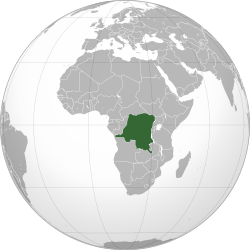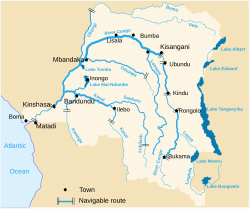Democratic Republic of the Congo
The Democratic Republic of the Congo (French: République démocratique du Congo), commonly referred to as DR Congo, Congo-Kinshasa or the DRC, is a country in central Africa. It was known as Zaïre from 1971 to 1997. It is the second largest country in Africa by area and the eleventh largest in the world. With a population of over 71 million,[1] the Democratic Republic of the Congo is the nineteenth most populous nation in the world, the fourth most populous nation in Africa, as well as the most populous Francophone (French-speaking) country.
Democratic Republic of the Congo République démocratique du Congo (French) Repubilika ya Kôngo ya Dimokalasi (Kongo) Republíki ya Kongó Demokratíki (Lingala) Jamhuri ya Kidemokrasia ya Kongo (Swahili) Ditunga dia Kongu wa Mungalaata (Luba-Katanga) | |
|---|---|
| Motto: "Justice – Paix – Travail" (French) "Justice – Peace – Work" | |
| Anthem: Debout Congolais (French) "Arise, Congolese" | |
 Location of Democratic Republic of the Congo (dark green) | |
| Capital and largest city | Kinshasa 4°19′S 15°19′E / 4.317°S 15.317°E |
| Official languages | French & Swahili |
| Recognised national languages | Lingala Kikongo Tshiluba |
| Ethnic groups | See Ethnic groups section below |
| Demonym(s) | Congolese |
| Government | Unitary semi-presidential republic |
| Félix Tshisekedi | |
| Judith Suminwa Tuluka | |
| Legislature | Parliament |
| Senate | |
| National Assembly | |
| Formation | |
| 17 November 1879 | |
| 1 July 1885 | |
| 15 November 1908 | |
• Independence from Belgium | 30 June 1960[1] |
| 20 September 1960 | |
• Renamed to Democratic Republic of Congo | 1 August 1964 |
| 29 October 1971 | |
| 17 May 1997 | |
| 18 February 2006 | |
| Area | |
• Total | 2,345,409 km2 (905,567 sq mi) (11th) |
• Water (%) | 3.32 |
| Population | |
• 2021 estimate | 95,894,118[2][3] (16th) |
• Density | 34.83/km2 (90.2/sq mi) |
| GDP (PPP) | 2017 estimate |
• Total | $67.988 billion[4] |
• Per capita | $785[4] |
| GDP (nominal) | 2017 estimate |
• Total | $40.415 billion[4] |
• Per capita | $446[4] |
| Gini (2006) | medium |
| HDI (2018) | low · 176th |
| Currency | Congolese franc (CDF) |
| Time zone | UTC+1 to +2 (WAT and CAT) |
| Driving side | right |
| Calling code | +243 |
| ISO 3166 code | CD |
| Internet TLD | .cd |

DRC borders the Central African Republic and South Sudan to the north; Uganda, Rwanda, and Burundi in the east; Zambia and Angola to the south; the Republic of the Congo, the Angolan exclave of Cabinda, and the Atlantic Ocean to the west. It is separated from Tanzania by Lake Tanganyika in the east.[1] The country has access to the ocean through a 40-kilometre (25 mi) stretch of Atlantic coastline at Muanda and the roughly 9 km wide mouth of the Congo River which opens into the Gulf of Guinea. It has the second-highest total Christian population in Africa.
History
changeWhen the Belgian Congo became independent, its leaders fought each other. The Soviet Union and later the United Nations helped destroy the groups who wanted independence from the new country.
The Second Congo War, beginning in 1998, devastated the country. It involved nine African nations and some twenty armed groups.[7] Despite the signing of peace accords in 2003, fighting continues in the east of the country. There, the prevalence of rape and other sexual violence is described as the worst in the world.[8] The war is the world's deadliest conflict since World War II, killing 5.4 million people since 1998.[9][10] The vast majority died from conditions of malaria, diarrhea, pneumonia and malnutrition.[11]
The Democratic Republic of the Congo was formerly, in chronological order, the Congo Free State, Belgian Congo, Congo-Léopoldville, Congo-Kinshasa, and Zaire (Zaïre in French).[1] Though it is in the Central African United Nations subregion, the nation is also economically and regionally affiliated with Southern Africa as a member of the Southern African Development Community (SADC).
Geography
changeThe country is bordered by Angola, the South Atlantic Ocean, the Republic of Congo, the Central African Republic, South Sudan, Uganda, Rwanda, Burundi, Tanzania across Lake Tanganyika, and Zambia.
The capital of the Democratic Republic of Congo is Kinshasa.
World Heritage Sites in the Democratic Republic of Congo include Virunga National Park (1979), Garamba National Park (1980), Kahuzi-Biega National Park (1980), Salonga National Park (1984) and Okapi Wildlife Reserve (1996).
Provinces
changeThe country is divided into twenty six provinces. The provinces are then divided into districts. The districts are divided into territories.[1]
Related pages
changeReferences
change- ↑ 1.0 1.1 1.2 1.3 1.4 Central Intelligence Agency (2014). "Democratic Republic of Congo". The World Factbook. Langley, Virginia: Central Intelligence Agency. Archived from the original on 18 May 2020. Retrieved 20 March 2020.
- ↑ "World Population Prospects 2022". population.un.org. United Nations Department of Economic and Social Affairs, Population Division. Retrieved July 17, 2022.
- ↑ "World Population Prospects 2022: Demographic indicators by region, subregion and country, annually for 1950-2100" (XSLX). population.un.org ("Total Population, as of 1 July (thousands)"). United Nations Department of Economic and Social Affairs, Population Division. Retrieved July 17, 2022.
- ↑ 4.0 4.1 4.2 4.3 "Democratic Republic of the Congo". International Monetary Fund.
- ↑ "GINI index". World Bank. Retrieved 30 July 2013.
- ↑ "2018 Human Development Report". United Nations Development Programme. 2018. Archived from the original on 14 September 2018. Retrieved 14 September 2018.
- ↑ See "Rumblings of war in heart of Africa" by Abraham McLaughlin and Duncan Woodside The Christian Science Monitor 23 June 2004 and "World War Three" Archived 2009-01-11 at the Wayback Machine by Chris Bowers My Direct Democracy 24 July 2006
- ↑ McCrummen, Stephanie (9 September 2007). "Prevalence of Rape in E. Congo Described as Worst in World". Washington Post. Retrieved 2 May 2010.
- ↑ Robinson, Simon (28 May 2006). "The deadliest war in the world". Time.com. Archived from the original on 17 June 2010. Retrieved 2 May 2010.
- ↑ Bavier, Joe (22 January 2008). "Congo War driven crisis kills 45,000 a month". Reuters. Retrieved 2 May 2010.
- ↑ Report on the crisis Archived 2012-03-03 at the Wayback Machine Full report at IRC mortality facts from the International Rescue Committee

